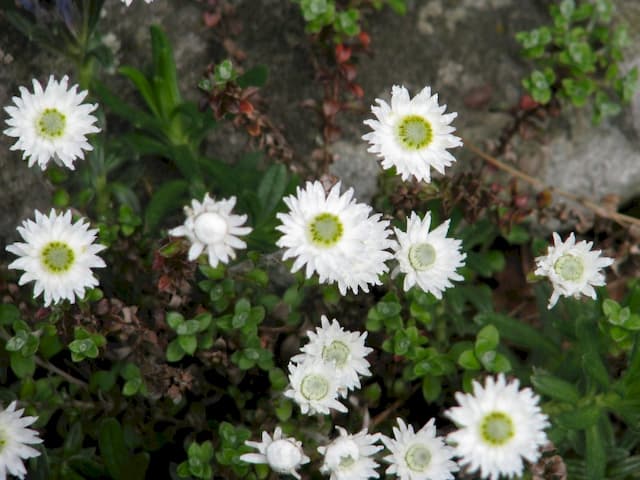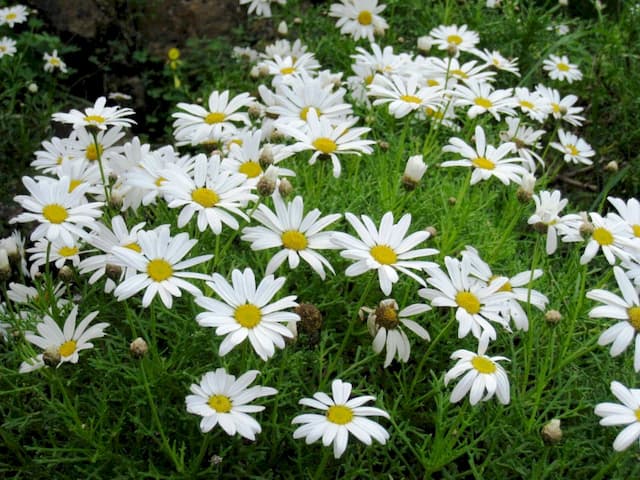Cabbage Thistle Cirsium oleraceum






ABOUT
Cirsium oleraceum, commonly known as the cabbage thistle, is a perennial plant characterized by its spiny, deeply lobed leaves, which often are a light, yellowish-green. The foliage gives the plant a slightly prickly appearance, though the spines are typically less formidable compared to other thistles. The cabbage thistle bears attractive, globe-shaped flower heads that are usually creamy white, sometimes with a hint of pale yellow. The flowers are surrounded by a loose arrangement of spiny bracts that can have a slightly webbed texture. The plant has a clumping form with several leafy stems branching out from the base, each stem topped with its own flower head. These bloom heads are a magnet for bees and other pollinators, who are attracted to the nectar and pollen. The cabbage thistle's overall appearance is quite striking in a natural meadow or garden setting, where its softer color palette and textured leaves add a unique visual interest.
About this plant
 Names
NamesFamily
Asteraceae
Synonyms
Cabbage Thistle, Cauliflower Thistle, Celery-leaved Thistle
Common names
Carduus oleraceus, Cirsium laetum, Cnicus oleraceus, Cirsium carniolicum.
 Toxicity
ToxicityTo humans
The Cirsium oleraceum, commonly known as the cabbage thistle, is generally not considered toxic to humans. There is no well-documented evidence of poisoning or serious side effects due to consumption or contact with this plant. It is, in fact, sometimes used as an edible plant, with the young shoots and leaves being eaten as a vegetable. Therefore, ingesting parts of the cabbage thistle typically does not lead to poisoning in humans.
To pets
The Cirsium oleraceum, known as the cabbage thistle, is not known to be toxic to pets either. It is not listed among the plants that commonly cause poisoning in domestic animals such as dogs and cats. Consequently, if a pet ingests parts of the cabbage thistle, it is unlikely to suffer from significant toxic effects or symptoms of poisoning purely due to this plant. However, each animal may react differently to various plant materials, and it is always prudent to monitor for any unusual signs and consult a veterinarian if concerns arise after ingestion.
 Characteristics
CharacteristicsLife cycle
Biennials
Foliage type
Deciduous
Color of leaves
Green
Flower color
Yellow
Height
3-4 feet (0.9-1.2 meters)
Spread
2-3 feet (0.6-0.9 meters)
Plant type
Herb
Hardiness zones
3
Native area
Europe
Benefits
 General Benefits
General Benefits- Ecological Importance: Cirsium oleraceum, commonly known as cabbage thistle, offers nectar and pollen for a variety of insects, including bees, butterflies, and other pollinators which are crucial for ecosystem health.
- Habitat Creation: It provides a habitat for certain species of birds and insects, contributing to the biodiversity of its natural surroundings.
- Soil Improvement: Its root system can help stabilize soil and prevent erosion by holding the soil together, thus maintaining the integrity of the landscape.
- Aesthetic Value: The cabbage thistle has distinctive foliage and attractive flower heads that can enhance the visual appeal of natural meadows and gardens where it grows.
- Wildlife Nutrition: The seeds and leaves of the plant can serve as a food source for various wildlife species, including some birds and mammals.
- Culinary Use: Although not widely known, the young shoots and leaves can sometimes be used in cooking similarly to other leafy greens, contributing to the plant's versatility.
 Medical Properties
Medical Properties- Anti-inflammatory: Cirsium oleraceum, commonly known as the Cabbage Thistle, is traditionally used to reduce inflammation.
- Diuretic: It has been used to promote the production of urine to aid in the elimination of fluid from the body.
- Astringent: Components of the Cabbage Thistle may be used for their astringent properties to help tighten tissues and reduce discharge.
- Wound healing: The plant has been utilized for its potential to aid in the healing of wounds.
- Digestive aid: Cirsium oleraceum is sometimes used to help with digestive issues such as indigestion or loss of appetite.
 Air-purifying Qualities
Air-purifying QualitiesThis plant is not specifically known for air purifying qualities.
 Other Uses
Other Uses- Cirsium oleraceum, commonly known as the cabbage thistle, can be used as an ornamental plant in gardens for its attractive flowers and foliage.
- The young shoots and stems of cabbage thistle can be eaten as a vegetable, either raw or cooked, similar to spinach or kale.
- The downy material on the seeds of cabbage thistle can be collected and used as a natural stuffing for pillows and mattresses.
- Cabbage thistle can be used as a natural dye, providing a range of colors from the plant depending on the mordant used.
- In traditional craftsmanship, the fibrous stems of cabbage thistle have been used to make paper products.
- Due to its deep roots, cabbage thistle can be planted for soil stabilization and to prevent erosion in vulnerable areas.
- The plant can be incorporated into a permaculture garden as a companion plant, attracting beneficial insects and pollinators with its flowers.
- With its tendency to grow in dense clumps, cabbage thistle can be utilized as a natural border or screen in landscaping projects.
- Farmers can use cabbage thistle as a forage plant for livestock, although it should be offered in moderation due to potential bitterness.
- The spiny architecture of cabbage thistle can provide a natural habitat and protection for small wildlife in the garden, such as insects and birds.
Interesting Facts
 Feng Shui
Feng ShuiThe Cabbage Thistle is not used in Feng Shui practice.
 Zodiac Sign Compitability
Zodiac Sign CompitabilityThe Cabbage Thistle is not used in astrology practice.
 Plant Symbolism
Plant Symbolism- Resilience: Cirsium oleraceum, commonly known as the Cabbage Thistle, often symbolizes resilience due to its ability to thrive in difficult conditions and withstand hardships.
- Protection: Thistles in general are seen as a symbol of protection because of their prickly exterior, suggesting the idea of safeguarding oneself or one's loved ones.
- Healing: Historically, some species of thistle have been used in herbal medicine. This lends the Cabbage Thistle a symbolic association with healing and health.
- Tenacity: The plant's vigorous growth habit and perseverance in colonizing areas can represent tenacity or determination in the face of adversity.
 Water
WaterThe Cabbage Thistle, commonly known as Cirsium oleraceum, thrives in consistently moist soil, so it’s important not to let the soil dry out completely. In general, water the plant deeply once a week, providing around 1 to 1.5 gallons of water each time, but this can vary depending on climate conditions – more frequent watering may be necessary during hot, dry spells. The best method of watering is to use a slow drip or trickle at the base of the plant to ensure that the water penetrates deeply into the soil, reaching the roots without oversaturating the surface. During the winter months or cooler weather, reduce the amount of water to prevent waterlogging. Always check the top inch of soil before watering; if it feels dry, it's time to water.
 Light
LightThe Cabbage Thistle requires full sunlight to partial shade to thrive. It is best to plant it in a location where it receives at least 6 hours of direct sunlight per day. However, it can tolerate some light shade, especially in areas with very intense midday sun. Avoid deep shade as it can lead to poor growth and reduced flowering.
 Temperature
TemperatureThe Cabbage Thistle is relatively cold-hardy and can tolerate temperatures down to some degree of frost but prefers a temperature range between 50°F and 75°F. It can survive minimum temperatures of around 20°F and maximum temperatures not exceeding 85°F for optimal growth. The plant is best grown in areas with milder summers and cooler winters within this ideal temperature range.
 Pruning
PruningPruning the Cabbage Thistle involves removing dead or damaged leaves and spent flower heads to maintain its appearance and encourage new growth. It is best pruned in late fall or early spring before new growth starts. Pruning is not frequently necessary but doing so once a year can help to rejuvenate the plant.
 Cleaning
CleaningAs needed
 Soil
SoilCabbage thistle thrives in moist, well-draining soil with a neutral to slightly alkaline pH, between 7.0 and 7.5. A mix of loamy soil with added organic matter like compost or well-rotted manure will support healthy growth.
 Repotting
RepottingCabbage thistle rarely needs repotting as it is typically grown as a biennial or short-lived perennial; transplanting is usually done for propagation or garden management purposes rather than for pot culture.
 Humidity & Misting
Humidity & MistingCabbage thistle prefers moderate to high humidity levels but is quite adaptable and can tolerate a range of conditions as long as the soil moisture is consistent.
 Suitable locations
Suitable locationsIndoor
Provide bright light, moist soil, and space.
Outdoor
Plant in full sun to partial shade, keep soil moist.
Hardiness zone
3-8 USDA
 Life cycle
Life cycleThe Cabbage Thistle (Cirsium oleraceum) begins its life cycle as a seed, which upon finding favorable conditions—moist, open soil with access to sunlight—germinates in the spring. The seedling stage follows, where the plant develops its initial root system and cotyledons (seed leaves) before true leaves appear. As it enters the vegetative stage, the Cabbage Thistle grows a rosette of spiny, lobed leaves close to the ground and a sturdy stem, during which it also develops a deep taproot. Flowering generally occurs in the summer of the following year, when the plant produces tall flower stalks topped with pale yellowish flower heads, which are attractive to a variety of insects, especially bees and butterflies. After pollination, typically involving these insects, the plant produces seed heads that eventually mature and release seeds, which are often dispersed by wind or animals. The Cabbage Thistle is a biennial or short-lived perennial, meaning that after seed production it may die or, if it is a perennial form, prepare to go through the process again during subsequent growing seasons.
 Propogation
PropogationPropogation time
Spring-Early Summer
The Cirsium oleraceum, commonly known as the Cabbage Thistle, is typically propagated by seeds. The optimal time to sow seeds is in the spring after the danger of frost has passed. To propagate by seed, one should scatter the seeds on the surface of a well-draining soil mix and lightly press them into the substrate without covering them completely, as they need light to germinate. It's important to keep the soil moist until germination, which usually occurs within two to three weeks. Once the seedlings have grown sufficiently and are sturdy enough to handle, they can be transplanted into individual pots or into their final position in the garden.









